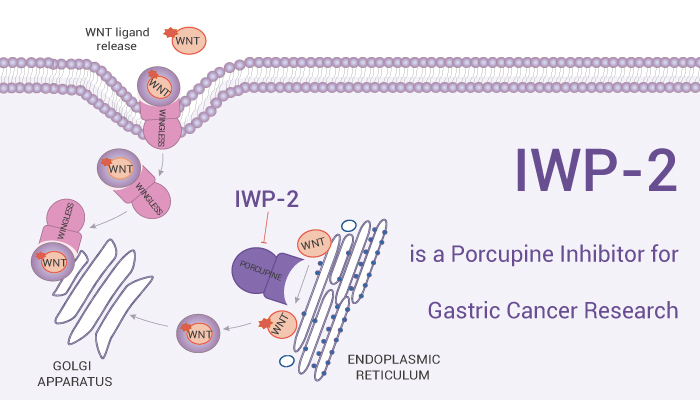The Wnt signaling pathway plays a crucial role in various developmental and disease processes. Porcupine (Porc) protein, an O-acyltransferase, is involved in the secretion and transport of Wnt proteins. Inhibition of Porc activity can disrupt Wnt signaling, making it an attractive target for therapeutic intervention.
Porcupine is actively involved in the secretion and lipid modification of Wnt proteins, playing a crucial role in Wnt signaling. In addition, studies using mutant Drosophila and C. elegans models have demonstrated that Porcupine homologs actively influence the secretion and localization of Wnt proteins, underscoring their significance in the regulation of Wnt signaling.

IWP-2: Targeting Wnt Signaling for Therapeutic Intervention
IWP-2: Inhibition of Porcupine Activity: IWP-2 is a small molecule inhibitor that targets the O-acyltransferase activity of Porcupine. By preventing the palmitoylation of Wnt ligands, IWP-2 disrupts Wnt processing and secretion, thereby inhibiting Wnt signaling.
In vitro, IWP-2 inhibits the proliferation of the investigated cell lines within the single digit μM range. IWP-2 inhibits cell proliferation in A818-6, MiaPaCa2, Panc-1, Panc-89, HT29, HEK293, SW620 and Capan cell with EC50s of 8.96 μM, 1.90 μM, 2.33 μM, 3.86 μM, 4.67 μM, 2.76 μM, 1.90 μM and 2.05 μM, respectively. Additionally, IWP-2 reduces the activity of CK1δ kinase, a key component of the Wnt signaling pathway, in Panc-1 cells.
In Vivo, IWP-2 has shown efficacy in reducing the uptake of blue beads and E. coli in mice. What’s more, The decrease in bacterial load is associated with reduced levels of pro-inflammatory cytokines TNF-α and IL-6. Additionally, there is an increase in the secretion of the anti-inflammatory cytokine IL-10.
In conclusion, IWP-2 is an inhibitor of Porcupine and Wnt signaling. So it holds promise as a therapeutic agent for diseases associated with dysregulated Wnt signaling. By disrupting the processing and secretion of Wnt ligands, IWP-2 can potentially modulate various cellular processes, including cell proliferation and inflammation.
Reference:
[1]. Nat Chem Biol. 2009 Feb;5(2):100-7.
[2]. J Med Chem. 2018 May 10;61(9):4087-4102.
[3]. Proc Natl Acad Sci U S A. 2012 Oct 9;109(41):16600-5.